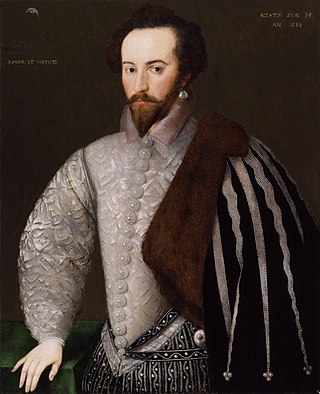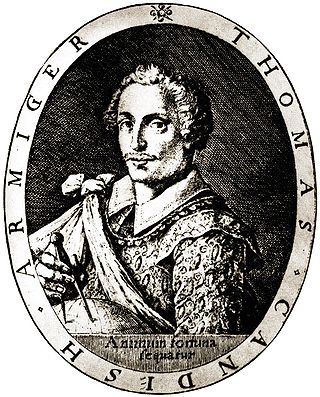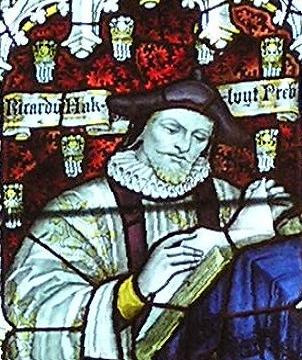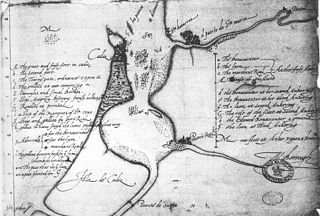Related Research Articles

Sir Walter Raleigh was an English statesman, soldier, writer and explorer. One of the most notable figures of the Elizabethan era, he played a leading part in English colonisation of North America, suppressed rebellion in Ireland, helped defend England against the Spanish Armada and held political positions under Elizabeth I.

The history of the Caribbean reveals the significant role the region played in the colonial struggles of the European powers since the 15th century. In the modern era, it remains strategically and economically important. In 1492, Christopher Columbus landed in the Caribbean and claimed the region for Spain. The following year, the first Spanish settlements were established in the Caribbean. Although the Spanish conquests of the Aztec empire and the Inca empire in the early sixteenth century made Mexico and Peru more desirable places for Spanish exploration and settlement, the Caribbean remained strategically important.

The British colonization of the Americas is the history of establishment of control, settlement, and colonization of the continents of the Americas by England, Scotland and, after 1707, Great Britain. Colonization efforts began in the late 16th century with failed attempts by England to establish permanent colonies in the North. The first of the permanent English colonies in the Americas was established in Jamestown, Virginia in 1607. Approximately 30,000 Algonquian peoples lived in the region at the time. Colonies were established in North America, Central America, South America, and the Caribbean. Though most British colonies in the Americas eventually gained independence, some colonies have remained under Britain's jurisdiction as British Overseas Territories.

The establishment of the Roanoke Colony was an attempt by Sir Walter Raleigh to found the first permanent English settlement in America. The colony was founded in 1585, but it was visited by a ship in 1590 and the crew found that the colonists had disappeared under unknown circumstances. It has come to be known as the Lost Colony, and the fate of the 112 to 121 colonists remains unknown to this day.

Sir Thomas Cavendish was an English explorer and a privateer known as "The Navigator" because he was the first who deliberately tried to emulate Sir Francis Drake and raid the Spanish towns and ships in the Pacific and return by circumnavigating the globe. Magellan's, Loaisa's, Drake's, and Loyola's expeditions had preceded Cavendish in circumnavigating the globe. His first trip and successful circumnavigation made him rich from captured Spanish gold, silk and treasure from the Pacific and the Philippines. His richest prize was the captured 600-ton sailing ship the Manila Galleon Santa Ana. He was knighted by Queen Elizabeth I of England after his return. He later set out for a second raiding and circumnavigation trip but was not as fortunate and died at sea at the age of 31.

Richard Hakluyt was an English writer. He is known for promoting the English colonization of North America through his works, notably Divers Voyages Touching the Discoverie of America (1582) and The Principal Navigations, Voyages, Traffiques and Discoveries of the English Nation (1589–1600).

The Company of One Hundred Associates, or Company of New France, was a French trading and colonization company chartered in 1627 to capitalize on the North American fur trade and to expand French colonies there. The company was granted a monopoly to manage the fur trade in the colonies of New France, which were at that time centered on the Saint Lawrence River valley and the Gulf of Saint Lawrence. In return, the company was supposed to settle French Catholics in New France. The Company of One Hundred Associates was dissolved by King Louis XIV, who incorporated New France into a province in 1663.
Martin Pring (1580–1626) was an English explorer from Bristol, England who in 1603 at the age of 23 was captain of an expedition to North America to assess commercial potential; he explored areas of present-day Maine, New Hampshire, and Cape Cod in Massachusetts. In the process, he named what is now Plymouth Harbor 'Whitson Bay' and a nearby hill 'Mount Aldworth' after the two Bristol merchants who provided him with ships and supplies. The harbour was later renamed by the Pilgrim fathers.

The Dutch–Portuguese War was a global armed conflict involving Dutch forces, in the form of the Dutch East India Company, the Dutch West India Company, and their allies, against the Iberian Union, and after 1640, the Portuguese Empire. Beginning in 1598, the conflict primarily involved the Dutch companies and fleet invading Portuguese colonies in the Americas, Africa, and the East Indies. The war can be thought of as an extension of the Eighty Years' War being fought in Europe at the time between Spain and the Netherlands, as Portugal was in a dynastic union with Spain after the War of the Portuguese Succession, for most of the conflict.
The European explorer-colonial historical record in North America begins in the second half of the 16th century, with ongoing European exploration.

The Battle of San Juan de Ulúa was fought between English privateers and Spanish forces at San Juan de Ulúa. The English flotilla of six armed merchant ships under John Hawkins had been trading along the Spanish Main with the cooperation of local Spanish officials. However the central Spanish authorities considered this to be illegal smuggling that violated the Treaty of Tordesillas.

Singeing the King of Spain's Beard is the derisive name given to a series of attacks by the English privateer Francis Drake against the Spanish in the summer of 1587, beginning in April with a raid on Cádiz. This was an attack on the Spanish naval forces assembling in the Bay of Cádiz in preparation for the planned expedition against England. Much of the Spanish fleet was destroyed, and substantial supplies were destroyed or captured. There followed a series of raiding parties against several forts along the Portuguese coast. A Spanish treasure ship, returning from the Indies, was also captured. The damage caused by the English delayed Spanish preparations for the Armada by at least a year.

The Secotans were one of several groups of Native Americans dominant in the Carolina sound region, between 1584 and 1590, with which English colonists had varying degrees of contact. Secotan villages included the Secotan, Aquascogoc, Dasamongueponke, Pomeiock (Pamlico) and Roanoac. Other local groups included the Chowanoke, Weapemeoc, Chesapeake, Ponouike, Neusiok, and Mangoak (Tuscarora), and all resided along the banks of the Albemarle and Pamlico sounds. They spoke Carolina Algonquian language, an Eastern Algonquian language.

The English overseas possessions, also known as the English colonial empire, comprised a variety of overseas territories that were colonised, conquered, or otherwise acquired by the former Kingdom of England during the centuries before the Acts of Union of 1707 between the Kingdom of England and the Kingdom of Scotland created the Kingdom of Great Britain. The many English possessions then became the foundation of the British Empire and its fast-growing naval and mercantile power, which until then had yet to overtake those of the Dutch Republic, the Kingdom of Portugal, and the Crown of Castile.

The history of the lumber industry in the United States spans from the precolonial period of British timber speculation, subsequent British colonization, and American development into the twenty-first century. Following the near eradication of domestic timber on the British Isles, the abundance of old-growth forests in the New World posed an attractive alternative to importing choice timber from the Baltic via the narrow straits and channels between Denmark and Sweden. The easily available timber proved an incredible resource to early settlers, with both domestic consumption and overseas trade fueling demand. The industry expanded rapidly as Americans logged their way across the country. In this pursuit, hundreds of thousands of indigenous peoples were displaced, murdered, and enslaved for the purpose of the timber industry.

The Battle of Flores (1592), also known as Cruising Voyage to the Azores of 1592, or the Capture of the Madre de Deus describes a series of naval engagements that took place from 20 May to 19 August 1592, during the Anglo-Spanish War. The battle was part of an expedition by an English fleet initially led by Sir Walter Raleigh, and then by Martin Frobisher and John Burgh. The expedition involved the capture of a number of Portuguese and Spanish ships including the large Portuguese carrack Madre de Deus, after a long naval battle off the island of Flores in the Azores. The expedition, particularly the capture of the great carrack, was a financial and military success. The rich cargo aboard the carrack, which at the time equaled nearly half the size of the Kingdom of England's royal annual revenue, was subject to mass theft when it arrived in Dartmouth, England, followed by quarrels over the shares of the prize. The expedition had formative consequences for the English both financially and on the future of English exploration.

The Blockade of Western Cuba, also known as the Watts' West Indies Expedition of 1591, was an English privateering naval operation that took place off the Spanish colonial island of Cuba in the Caribbean during the Anglo–Spanish War. The expedition along with the blockade took place between May and July 1591 led by Ralph Lane and Michael Geare with a large financial investment from John Watts and Sir Walter Raleigh. They intercepted and took a number of Spanish ships, some of which belonged to a Spanish plate convoy of Admiral Antonio Navarro, and protected by the Spanish navy under Admiral Diego de la Ribera intending to rid English privateers. The English took or burnt a total of ten Spanish ships including two galleons, one of which was a valuable prize. With this success and the loss of only one ship the blockade and expedition was terminated for the return to England. The blockade was one of the most successful English expeditions to the Spanish Main during the war militarily and financially.

The Newfoundland Expedition also known as Bernard Drake's Newfoundland Expedition was an English naval expedition that took place during the beginning of the declared Anglo-Spanish War in the North Atlantic during summer and autumn of 1585. The area of conflict was situated mainly in an area known as the Grand Banks off present day Newfoundland. The aim of the expedition was to capture the Spanish and Portuguese fishing fleets. The expedition was a huge military and financial success and virtually removed the Spanish and Portuguese from these waters. In addition the raid had large consequences in terms of English colonial expansion and settlement.

Watts' West Indies and Virginia expedition also known as the Action of Cape Tiburon was an English expedition to the Spanish Main during the Anglo–Spanish War. The expedition began on 10 May and ended by 18 July 1590 and was commanded by Abraham Cocke and Christopher Newport. This was financed by the highly renowned London merchant John Watts. The English ships intercepted and dispersed Spanish convoys capturing, sinking, and grounding many ships off the Spanish colonies of Hispaniola, Cuba, and Jamaica. Despite losing an arm, Newport was victorious and captured a good haul of booty. A breakaway expedition from this discovered that the Roanoke Colony was completely deserted and which gave the name The Lost Colony.

Francis Drake's circumnavigation, also known as Drake's Raiding Expedition, was an important historical maritime event that took place between 15 December 1577 and 26 September 1580. The expedition was authorised by Queen Elizabeth I and consisted of five ships led by Francis Drake. Termed a 'voyage of discovery', it was in effect an ambitious covert raiding voyage and the start of England's challenge to the global domination of Spain and Portugal.
References
- ↑ nationalhumanitiescenter.org
- ↑ swarthmore.edu
- ↑ Parks, George Bruner (1961). Richard Hakluyt and the English voyages. New York: F. Ungar Pub. Co. p. 88.